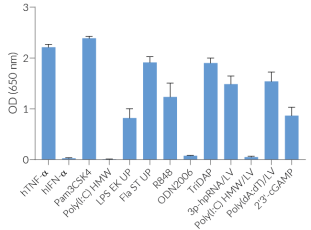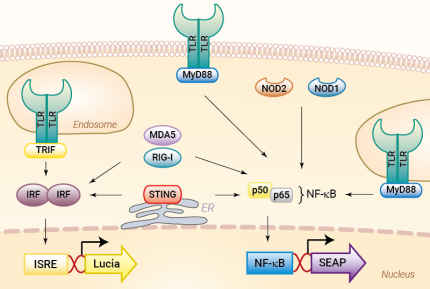THP1-Dual™ Cells
-
Cat.code:
thpd-nfis
- Documents
ABOUT
NF-κB–SEAP and IRF–Lucia reporter human monocytes
THP1-Dual™ cells were derived from the human THP-1 monocyte cell line by stable integration of two inducible reporter constructs.
As a result, THP1-Dual™ cells allow the simultaneous study of the NF-κB pathway, by monitoring the activity of SEAP, and the IRF pathway, by assessing the activity of a secreted luciferase, Lucia luciferase.
Both reporter proteins are readily measurable in the cell culture supernatant when using QUANTI-Blue™ Solution, a SEAP detection reagent, and QUANTI-Luc™ 4 Lucia/Gaussia, a Lucia and Gaussia luciferase detection reagent.
THP1-Dual™ cells induce the activation of NF-κB in response to certain TLR agonists, such as Pam3CSK4 and flagellin. They trigger the IRF pathway upon stimulation with type I IFNs and RLR or CDS agonists, such as transfected dsRNA.
THP1-Dual™ cells are resistant to the selectable markers Zeocin® and blasticidin.
Disclaimer: These cells are for internal research use only and are covered by a Limited Use License (See Terms and Conditions). Additional rights may be available.
SPECIFICATIONS
Specifications
Screening of PRR agonists or inhibitors
Complete RPMI 1640 (see TDS)
Verified using PlasmotestTM
Each lot is functionally tested and validated.
CONTENTS
Contents
-
Product:THP1-Dual™ Cells
-
Cat code:thpd-nfis
-
Quantity:3-7 x 10^6 cells
- 1 ml of Normocin™ (50 mg/ml)
- 1 ml of Zeocin® (100 mg/ml)
- 1 ml of Blasticidin (10 mg/ml)
- 1 tube of QUANTI-Luc™ 4 Reagent
- 1 ml of QB reagent and 1 ml of QB buffer
See Technical Data sheet for storage information
Shipping & Storage
- Shipping method: Dry ice
- Liquid nitrogen vapor
- Avoid repeated freeze-thaw cycles
Storage:
Caution:
Description
THP1-Dual™ cells feature the Lucia gene, a secreted luciferase reporter gene, under the control of an ISG54 minimal promoter in conjunction with five IFN-stimulated response elements.
THP1-Dual™ cells also express a secreted embryonic alkaline phosphatase (SEAP) reporter gene driven by an IFN-β minimal promoter fused to five copies of the NF-κB consensus transcriptional response element and three copies of the c-Rel binding site.
As a result, THP1-Dual™ cells allow the simultaneous study of the NF-κB pathway, by monitoring the activity of SEAP, and the IRF pathway, by assessing the activity of Lucia luciferase.
DOCUMENTS
Documents
Technical Data Sheet
Safety Data Sheet
Validation Data Sheet
Certificate of analysis
Need a CoA ?


